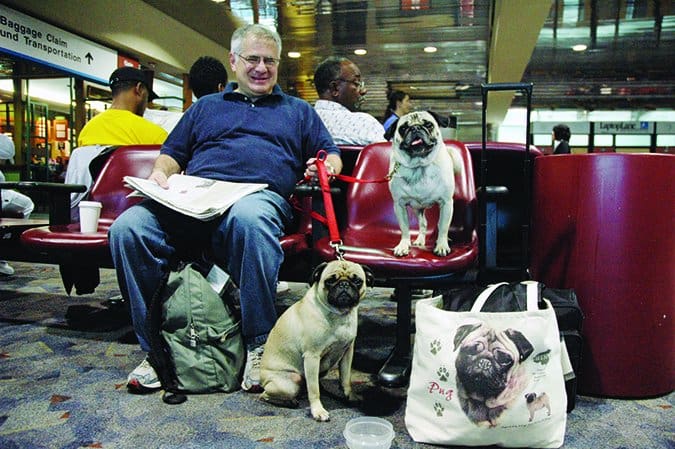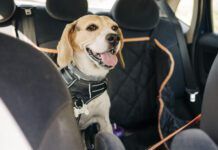[Updated March 2, 2017]
The ability to carry a little dog onto an airplane with you is one of the greatest advantages of owning a small dog that can’t be shared by owners of medium or large dogs. Most (though not all) of the risks of flying a dog on a commercial flight are posed by the dog’s handling by airport employees behind the scenes and by the dog’s unattended experience in the cargo hold of the plane; in contrast, the risks to a dog who is with you at every moment of your flight are very slight – and under your control. That said, there are a lot of things you need to know and contingencies for which to prepare if you are going to subject your dog to air travel. Here’s how to make the carried-on dog’s flight as enjoyable and stress free (for both of you) as possible.

Prepare Your Dog for Air Travel
Before you count on being able to bring your dog on any flight with you, you should be aware that there is no cut-and-dried rule regarding the size of dogs who can be carried on a plane. Most accurately, the limiting factor for which dogs can be carried onto a flight is the size of the dog’s carrier, and how well the dog appears to fit inside it. But every airline has different maximum dimensions for kennels and soft-sided carriers – and airlines sometimes have different maximum dimensions for the various types of airplane that may be employed on your journey. And there is quite a range! I found airlines with stated maximum carrier heights as small at 7.5 inches (in this case, for a hard-sided carrier on Alaska and United), and as much as 11 inches (and in this case, specifically for a soft-sided carrier on United). The maximum dimensions for the width and depth of the carrier vary quite a bit, too. We found a range of maximum carrier width from 11 to 19 inches, and a range of maximum length from 12 to 19 inches.
In addition to their carrier dimension limitations, some airlines also have a weight limit for the pet and her carrier. For example, JetBlue dictates that the combined weight of the dog and carrier cannot exceed 20 pounds.
Dogs are supposed to be able to stand up, turn around, and lie down naturally and comfortably in the carrier. It doesn’t pay to try to stuff a borderline too-large dog into a small kennel; airline representatives, who may or may not be knowledgeable about pets, can refuse to allow you to board with your dog if they feel the kennel is too small and causing (or potentially causing) your dog undue distress.
On top of the size and weight considerations, there are federal regulations regarding the minimum age for puppies who can be carried on a plane. These regulations (and common sense) require puppies to be at least eight weeks old and weaned at least five days before flying.
If your dog is small enough to fit comfortably into a carrier that will meet the airline’s size specifications for the plane used on the journey you plan to take, read on!
Buying the Plane Ticket
It’s weird and annoying: I haven’t yet seen an airline’s website that allows a traveler to indicate that she would like to bring a pet on board for a flight. Generally, you first book the flight for yourself, and then call the airline directly to reserve a spot for your dog. That’s a weird order of operations, given that airlines allow only a limited number of pets on any given flight; if the flight you have booked for yourself already has reached its capacity for pets, you will have to select a different flight. Although the airline won’t charge a “change fee” for this, if the new flight costs more than the one you originally booked, you will have to pay the higher price. Take home point: Book your flight as early as possible, and call the airline to reserve a spot for your dog immediately after booking.
Dog Health Requirements for Air Travel
When you make the phone call to reserve your dog’s spot on your flight, ask the reservation agent whether any health certificates or vaccinations are required for your dog for that flight. A health certificate, issued by a veterinarian who examined your dog within a short period (usually 10 days) before your flight, is required for all international flights, but generally not for domestic travel in the U.S., with a couple of notable exceptions. Because Hawaii is the only place in the U.S. that is completely free of rabies, that state has special requirements for inbound pets. And certain destinations in Alaska have vaccination requirements (for canine parvovirus and rabies).
Pay a Pet Travel Fee
All airlines charge an extra fee for your carried-on dog, and the price (like all airline add-on fees) has gone up in recent years. Unlike the price of your ticket, the fee doesn’t seem to be dependent on the length of the flight; a flat fee is applied no matter how long (or short) the flight is, and varies from airline to airline, from about $125 to $200 (one way). Payment for the pet fee is made at the counter when you check in for the flight.
Getting Your Dog Ready to Fly
Ideally, you’ve bought your ticket and made your dog’s reservation months (or at least weeks) in advance of your flight. That gives you time to prepare your dog for some of the experiences she will be subjected to on the day of travel, so she’s not miserable on the airplane – and so you and your fellow passengers aren’t made miserable by her distressed behavior, either.
It’s most important for your dog to practice spending time in a small carrier – and, while there, being jostled about and subjected to strange noises and movement. Small dogs who are regularly carried in soft-sided bags are likely to accept everything about the air travel experience with ease. But if your dog has rarely graced the inside of a crate, or is unhappy being in one, you need to start conditioning and desensitizing her to this ASAP. (See “The Benefits of Crate Training,” WDJ January 2011, for more information about teaching a dog to be comfortable in a crate.)
Flying with Your Dog
Once your dog is comfortable spending time in a crate or carrier at home, make sure she is equally comfortable being carried in it, subjected to the sounds and motion of a vehicle in it (people who crate their dogs in the car, with the crate securely belted or strapped in, are way ahead of the game here), and will go into it happily at any time. Ideally, your dog will be familiar with and comfortable in the carrier you plan to use on the trip well before you travel; don’t subject her to an entirely new carrier on the day of the flight if you can help it.
You may need to take your dog out of and put her back into the carrier several times during your travel. The airline representative at the front counter might want to see your dog out of the carrier to make sure she’s in a correctly sized carrier. You will be asked to remove her from the carrier again when you go through security. If you have to change planes, you will probably want to seek out a “pet relief area” at the midway airport so your dog can go potty. You want to be able to remove your dog from the carrier without her trying to escape in a panic at all of these points, as well as at your final destination. So in the weeks before the flight, practice asking your dog to enter the carrier, and taking her out of it, in all sorts of different environments: dark, bright, loud, indoors, outdoors, etc. Keep the experience highly rewarding (with high-value treats and praise) each time she enters and exits calmly.
It’s also a good idea to bathe your dog a day or two before your trip, so that she’s odor free and comfortable.
Finally, make sure your dog’s nails (including the dewclaws, if any) are clipped short. A dog who tries to paw or dig her way out of a carrier can easily catch and tear a nail, especially in a soft-sided carrier. Bleeding, whining, and distress can follow. Having all the nails short and sound (not split and snaggy) will help prevent a slightly stressful trip from turning into a very stressful one.
Day of the Flight
It should go without saying that your dog should be wearing an ID tag with your current contact information on it; ideally this includes your current mobile number. It’s also best if your dog is microchipped (in case he somehow got his collar or harness off) and that the microchip registration is also up-to-date.
It’s usually recommended that you not feed your dog within six hours of a flight; you really don’t want him to vomit, urinate, or defecate in the carrier on the plane if you can help it. But whether or not you heed this recommendation totally depends on how well conditioned your dog is to spending time in the carrier. Dogs who are super comfortable spending even long stretches of time in their carriers aren’t likely to vomit or need to eliminate any more than usual. But if your dog is not as well accustomed to the carrier as he should be, is a nervous traveler anyway, can’t yet go for very long without needing to eliminate (like most puppies), or suffers from motion sickness in a car, you may want to withhold food and give him just small amounts of water in that time frame before flying.
Note: If you are flying with a very young puppy, or a toy breed puppy of any age, don’t withhold food before flying; you don’t want to add to the risk factors of hypoglycemia (low blood sugar). Hypoglycemic attacks can be brought on by stress, and may result in seizures, listlessness, muscle weakness or staggering, tremors (especially in the face), coma, and even death. The stress of shipping is a common cause of hypoglycemia in puppies, especially those of the toy breeds. Other causes include missing a meal, becoming chilled, and exhaustion (this can happen when people get a new puppy and, thrilled with their new friend, keep instigating play and not letting the puppy rest).
Start your day as early as necessary in order to have enough time to walk your dog far enough (or be outside long enough) so that he eliminates as fully as he ever does! Once you have arrived at the airport, give him a leisurely (not rushed) chance to urinate one more time outside before putting him in his carrier and taking him inside.
Never Accept Travel Condition Changes for Your Dog
Imagine this for a moment: You have arrived at the airport, dog in carrier and carrier in hand, and were told at the front counter that a mistake had been made and there was no room in the cabin for your dog after all. The airline could, however, put your dog in the cargo area. What would you do?
If this happened to you – as it has happened to more than one person I know! – I strongly suggest that you calmly refuse to allow your dog to be put in the cargo area, even if it meant you had to take another flight. If you had a legitimate reservation for your dog to be in the cabin, you should hold the airline to it, or accept their offer of reticketing (without fee) on another flight with an upgrade.
The only possible exception would be if your dog were completely comfortable being in a crate, without you, and with travel; you had an appropriately sized “hard” crate already; your dog is a fit, healthy, adult, non-brachycephalic breed; the weather conditions were perfect (neither at all hot nor at all cold); and the flight wasn’t a terribly long one. In my opinion, those are the only conditions under which any dog should be shipped via cargo – but honestly, somebody’s life would have to be at risk before I would consider letting my dog travel that way.
En Route
Check all the zippers and fasteners on your carrier carefully, to make sure they are completely closed, and can’t be pawed or nosed open. Some bags have double zippers with tabs that can be clipped together with the snap from your leash to ensure that the bag cannot be unzipped without unsnapping the tabs first.
Consider teaching your dog to lick water from the slightly opened spout of a sports bottle (sort of like a rabbit’s water bottle). You can bring an empty bottle through security, and fill it up from a water fountain in the gate area. That way, you can offer your dog an occasional lick of water on the flight if she’s panting or seems hot. If you are certain she won’t try to escape, you can offer this by unzipping one of the carrier’s doors just enough to permit the insertion of the tip of the sports bottle. Or just hold the tip up to the mesh of the bag; if she licks the mesh, she can still get enough water to wet her mouth.
Don’t break the rules and allow your dog out of her carrier on the plane; she’s far safer, and your fellow travelers will be far more comfortable, with your dog contained. Also, if your dog did vomit or relieve herself in the crate, letting her out will only make matters worse in terms of the mess and odor! Wait until you deplane to try to improve the situation. Ask a flight attendant or the gate attendant (upon deplaning) for the location of the nearest pet relief station and head straight there.
It should be a huge relief to you for both of you to have arrived safely!
Should You Tranquilize Your Dog?
Veterinarians generally advise against administering a tranquilizer to dogs for air travel. The American Veterinary Medical Association (AVMA) has a Traveling with Your Pet FAQ page on its website, with this statement: “It is recommended that you DO NOT give tranquilizers to your pet when traveling by air because it can increase the risk of heart and respiratory problems. Short-nosed dogs and cats sometimes have even more difficulty with travel. Airlines may require a signed statement that your pet has not been tranquilized prior to flying.”
The AVMA goes on to quote Dr. Patricia Olsen of the American Humane Association (AHA): “An animal’s natural ability to balance and maintain equilibrium is altered under sedation and when the kennel is moved, a sedated animal may not be able to brace and prevent injury.”
If you are concerned about your dog’s behavior or anxiety on an upcoming flight, spend time daily getting him accustomed to being in his carrier. See “The Benefits of Crating Training,” WDJ January 2011, for tips on teaching a dog to be happy in a crate.
What About Large Dogs as Cargo?
There are people who routinely airship dogs as cargo across the country. I am not and will never be one of those people.
The federal government requires airlines to report incidents to the U.S. Department of Transportation every time an animal on a commercial flight is injured, lost, or dies. The reports appear online in a remarkably timely fashion. The owners’ names are redacted but all the other basic facts about each incident are recounted in the reports.
If you spend a few hours reviewing those “animal incident reports,” you may find yourself turning in your dog’s wings. The reports describe pets who were sickened, injured, escaped from their crates, or lost during air travel – as well as those who were dead on arrival at their owner’s destination.
The reports certainly do serve to educate. Ongoing analysis of the reports (compiled since the law mandating their collection went into effect in 2005) has exposed the most potent dangers of air travel to pets. For example, in 2010, analysis of five years’ worth of animal incident reports revealed that dogs with short muzzles (such as Pugs, Boston Terriers, Boxers, some Mastiffs, Pekingese, Lhasa Apsos, Shih Tzus, and Bulldogs) are much more likely to die on airplanes than dogs with normal-length muzzles. One-half of the 122 dog deaths associated with airline flights in that time span involved these short-faced breeds.
An alarming number of incident reports involve dogs who manage to escape from their crates (and are found by the ground crew at their destination loose in the cargo hold), dogs who were injured in frantic attempts to escape from their crates – descriptions of blood-spattered crates and limping dogs dot the incident reports – and crates that are found to be cracked upon arrival.
Industry observers say that since the airlines (those operating airplanes that seat more than 60 passengers) have been required to collect and publish these reports, the number of incidents have gone down. Industry spokesmen tend to minimize the number of pet losses; you will find all sorts of projections – based on estimations of the total number of pets flown on airlines – as to the rate of pet injury or loss that make air travel look very safe for your dog.
However, it’s far less safe for your pet to fly than it is for you. It’s telling that most of the airlines have increased the number of limitations on which pets they will accept as cargo, on which routes, and at what times of year. And some airlines no longer accept pets as cargo at all.
Alternatives to Cargo Flights For Transporting a Dog
Before flying a dog as cargo, I would recommend exhausting every other option for moving a dog from one place to another, such as:
-Chartered flight (where even large dogs are allowed in the cabin). Example: Magellan Jets
– Professional pet ground transportation service. Example: Royal Paws
– Driving the pet yourself.
– Transatlantic move? Cunard’s Queen Mary 2 (QM2) is the only ship that allows the transatlantic transportation of dogs.
No Alternative?
If you had to ship a dog as cargo, consider the following:
– Dogs with any sort of breathing or cardiac impairment, those who are elderly, obese, and/or in poor health, very young puppies (especially those of toy breeds), and brachycephalic (flat-faced dogs) are at extremely high risk when flying.
– Do not ship during times of year when extremely hot or cold weather can add to the risk.
– Choose an itinerary with the shortest flight time and direct route to minimize extraneous moving (and potential mishandling) of your dog’s crate.
Thoroughly condition and desensitize your dog to spending long periods in the crate, and being in the crate when it is transported. Load and unload the crate into your car with your dog in it, and take long drives with him in the crate. If he shows signs of anxiety or discomfort during these trips (panting, whining, barking, pawing or chewing at the gate, trying to escape, etc.), understand that he will be even more anxious (if not panic-stricken) in the crate as it is handled by baggage crews – and when unattended in the baggage hold during the flight or flight delays.
Buy the strongest, heaviest crate you can buy.
Follow (and exceed) all of the airline’s rules for fastening and labeling the crate. Experienced shippers drill holes near the crate door and use plastic zip ties to keep the door closed in the event that the spring-loaded latch gets jostled open.
Get more information on flying with your dog at Dogster.com.






Amazing article. Actually, I was planning a trip with my dog but I was worried about safety and preparation for the trip. You have mentioned every detail and now I am much more confident and I am definitely going to a trip with him after this virus is gone.